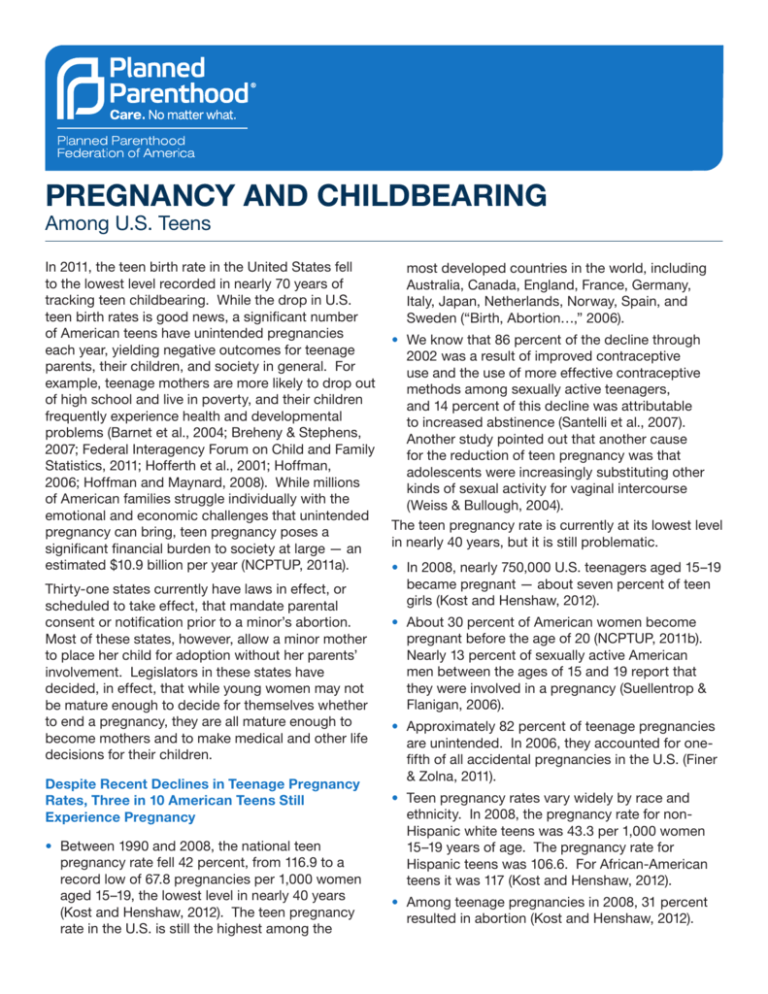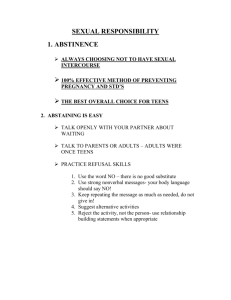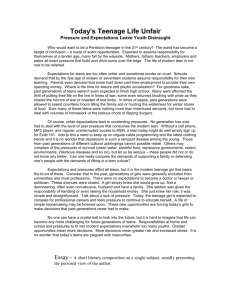
PREGNANCY AND CHILDBEARING
Among U.S. Teens
In 2011, the teen birth rate in the United States fell
to the lowest level recorded in nearly 70 years of
tracking teen childbearing. While the drop in U.S.
teen birth rates is good news, a significant number
of American teens have unintended pregnancies
each year, yielding negative outcomes for teenage
parents, their children, and society in general. For
example, teenage mothers are more likely to drop out
of high school and live in poverty, and their children
frequently experience health and developmental
problems (Barnet et al., 2004; Breheny & Stephens,
2007; Federal Interagency Forum on Child and Family
Statistics, 2011; Hofferth et al., 2001; Hoffman,
2006; Hoffman and Maynard, 2008). While millions
of American families struggle individually with the
emotional and economic challenges that unintended
pregnancy can bring, teen pregnancy poses a
significant financial burden to society at large — an
estimated $10.9 billion per year (NCPTUP, 2011a).
Thirty-one states currently have laws in effect, or
scheduled to take effect, that mandate parental
consent or notification prior to a minor’s abortion.
Most of these states, however, allow a minor mother
to place her child for adoption without her parents’
involvement. Legislators in these states have
decided, in effect, that while young women may not
be mature enough to decide for themselves whether
to end a pregnancy, they are all mature enough to
become mothers and to make medical and other life
decisions for their children.
Despite Recent Declines in Teenage Pregnancy
Rates, Three in 10 American Teens Still
Experience Pregnancy
• Between 1990 and 2008, the national teen
pregnancy rate fell 42 percent, from 116.9 to a
record low of 67.8 pregnancies per 1,000 women
aged 15–19, the lowest level in nearly 40 years
(Kost and Henshaw, 2012). The teen pregnancy
rate in the U.S. is still the highest among the
most developed countries in the world, including
Australia, Canada, England, France, Germany,
Italy, Japan, Netherlands, Norway, Spain, and
Sweden (“Birth, Abortion…,” 2006).
• We know that 86 percent of the decline through
2002 was a result of improved contraceptive
use and the use of more effective contraceptive
methods among sexually active teenagers,
and 14 percent of this decline was attributable
to increased abstinence (Santelli et al., 2007).
Another study pointed out that another cause
for the reduction of teen pregnancy was that
adolescents were increasingly substituting other
kinds of sexual activity for vaginal intercourse
(Weiss & Bullough, 2004).
The teen pregnancy rate is currently at its lowest level
in nearly 40 years, but it is still problematic.
• In 2008, nearly 750,000 U.S. teenagers aged 15–19
became pregnant — about seven percent of teen
girls (Kost and Henshaw, 2012).
• About 30 percent of American women become
pregnant before the age of 20 (NCPTUP, 2011b).
Nearly 13 percent of sexually active American
men between the ages of 15 and 19 report that
they were involved in a pregnancy (Suellentrop &
Flanigan, 2006).
• Approximately 82 percent of teenage pregnancies
are unintended. In 2006, they accounted for onefifth of all accidental pregnancies in the U.S. (Finer
& Zolna, 2011).
• Teen pregnancy rates vary widely by race and
ethnicity. In 2008, the pregnancy rate for nonHispanic white teens was 43.3 per 1,000 women
15–19 years of age. The pregnancy rate for
Hispanic teens was 106.6. For African-American
teens it was 117 (Kost and Henshaw, 2012).
• Among teenage pregnancies in 2008, 31 percent
resulted in abortion (Kost and Henshaw, 2012).
Factors that Increase the Risk of Teen Pregnancy
• Age of first sex is an important determinant of
pregnancy risk. Forty-six percent of teenage girls
and 22 percent of teenage boys who engage in
their first sexual experience before the age of 15
have been involved in a pregnancy. For teens
who engage in their first sex experience at age 15
or older, the risk declines to 25 percent and nine
percent, respectively (Suellentrop & Flanigan, 2006).
• Teens who use contraception during their first
sexual experience are less likely to experience a
pregnancy. Twenty-seven percent of teen girls and
12 percent of teen boys who used contraception
at first sex have been involved in a pregnancy.
For teens who did not use contraception at first
sex, 43 percent of girls and 18 percent of boys
have been involved in a pregnancy (Suellentrop &
Flanigan, 2006).
• Teenage girls with older partners are more likely to
become pregnant than those with partners closer
in age. Likewise, teenage boys with older partners
are more likely to father a child. A study found that
6.7 percent of women aged 15–17 have partners six
or more years older than they are. The pregnancy
rate for this group is 3.7 times as high as the rate
for those whose partner is no more than two years
older (Darroch et al., 1999). A later study found that
women who had sex before age 16 with a partner
three or more years older were more likely to have a
teenage birth than others (41–46 percent vs. 19–34
percent). Men who had sex before age 16 with
an older partner were more than twice as likely to
father a child during their teenage years compared
with those who postponed sex until age 16–17
(Manlove et al., 2006).
• The greater the number of sex partners, the more
likely teens are to be involved in a pregnancy.
Thirty-seven percent of teen girls and 18 percent of
teen boys with three or more partners have either
experienced or have been involved in a pregnancy.
When the number of partners drops to less than two,
only 25 percent of teen girls and nine percent of teen
boys have experienced or have been involved in a
pregnancy (Suellentrop & Flanigan, 2006).
The Rate of Teenage Childbearing in the U.S.
Is the Highest Among the Most Developed
Countries
• Despite the historically low current rate, the U.S.
teenage birth rate is the highest among the most
developed countries in the world: twice as high
as Australia’s and Canada’s three times as high
as France’s, three and a half times as high as
Germany’s, six times as high as the Netherlands’,
and seven times as high as Japan’s (Hamilton et
al., 2012; United Nations, 2012).
TEEN BIRTH RATES
(per 1,000 women aged 15-19)
45
40
35
30
25
20
15
10
5
0
31.3
4.6
5.1
8.9
10.2
14.1
15.4
• Reasons for the lower rates of teenage
childbearing in these countries include
• mandatory, medically accurate sexuality
education programs that provide comprehensive
information and encourage teens to make
informed decisions;
• access to contraception and other forms of
reproductive health care, including abortion;
• social acceptance of adolescent sexual
expression as normal and healthy;
• straightforward public health media campaigns; and
• government support for the right of teens to
accurate information and confidential services
(Berne & Huberman, 1999).
• In 2011, nine percent of all U.S. births were to
teens (Hamilton et al., 2012).
• Preliminary findings show that in 2011, 329,797
women aged 15–19 gave birth, a rate of 31.3 live
births per 1,000 women in this age group. This figure
marks an eight percent decrease from the 2010 rate
and a record low for the U.S. (Hamilton et al., 2012).
• The preliminary birth rate in 2011 for young teens
was 0.4 births per 1,000 women aged 10–14,
the lowest level ever reported. This reduction
in birth rate is extremely encouraging because
young teens have a higher risk of pregnancy
complications (Hamilton et al., 2012).
• The preliminary teenage birth rate in 2011 was 15.4
births per 1,000 women aged 15–17, and 54.1 births
per 1,000 women aged 18–19. That year, the birth
rate for teens aged 15–19 was 49.4 per 1,000 for
Hispanics, 47.4 per 1,000 for African Americans, and
21.8 per 1,000 for non-Hispanic whites. The rates
for all race and Hispanic-origin groups reached
historic lows in 2011 (Hamilton et al., 2012).
• Eighty-nine percent of teens aged 15–19 — 95
percent aged 15–17 and 86 percent aged 18–19 —
who gave birth in 2011 were unmarried. In 2011,
teens accounted for only 18 percent of all births
outside of marriage — a decline from 50 percent in
1970 (Hamilton et al., 2012).
• In 2010, nearly 1 in 5 births (18 percent) to teens
aged 15–19 was a repeat birth — the second
or more birth before age 20. This is down 6.2
percent from 2007. Most (86 percent) repeat births
were second births. The prevalence of repeat teen
births in 2010 was 20.9 percent among Hispanics,
20.4 percent among non-Hispanic African
Americans, and 14.8 percent among non-Hispanic
whites (Gavin et al., 2013).
• Infants born from a repeat teen birth are more
likely to be preterm or low birth weight — in 2010,
17 percent of infants who were second teen births
were born preterm compared to 12.6 percent for
first births, and 11 percent of second teen births
were low birth weight, compared to nine percent
of first births. Repeat births might also negatively
affect teen mothers’ ability to attend school and
obtain job experience (Gavin et al, 2013).
• A Guttmacher Institute analysis shows that
this drop in teen birth rates “can be linked
almost exclusively to improvements in teens’
contraceptive use.” While there was no significant
change in sexual activity among women aged
15–19 years, teens use of hormonal contraceptives
increased from 37.3 percent in 2006–2008 to 47.5
percent in 2008–2010. Use of more than one
contraceptive method also increased from 16.1
percent to 23.2 percent, as did use of long-acting
methods such as IUDs, growing from 1.4 percent
to 4.4 percent (Guttmacher Institute, 2011).
Teenage Childbearing and Parenting
• In general, teenage mothers do not fare as well as
their peers who delay childbearing:
• Their family incomes are lower.
• They are more likely to be poor and receive
public assistance.
• They are less educated.
• They are less likely to be married.
• Their children lag in standards of early
development. (Breheny & Stephens, 2007;
Hoffman, 2006; NCPTUP, 2010)
• Only 63 percent of teenagers who give birth before
the age of 18 and 74 percent of teenagers who give
birth between the ages of 18 and 19 either graduate
from high school or receive their GED, as compared
to approximately 85 percent of women who delay
childbirth until their early 20s (Hoffman, 2006; LevinEpstein & Schwartz, 2005). Nearly one-third of teen
girls who have dropped out of high school say that
pregnancy or parenthood is a key reason, and rates
are even higher for African Americans (38 percent)
and Latinos (36 percent) (Shuger, 2012).
• By the age of 30, only five percent of young teen
mothers and 10 percent of older teen mothers
complete at least two years of college, and less
than two percent of young teen mothers and three
percent of older teen mothers obtain a college
degree. Comparatively, 21 percent of women who
delay childbirth complete at least two years of
college, and nine percent graduate (Hoffman, 2006).
• Nearly 80 percent of teen mothers receive some
form of public assistance, i.e., food stamps,
housing assistance, Temporary Assistance for
Needy Families (TANF), or Special Supplemental
Nutrition Program for Women, Infants, and
Children (WIC) vouchers (Acs & Koball, 2003).
Teen mothers not only receive more financial
assistance, but they also receive this assistance
longer than do women who delay their childbirth
(Hoffman, 2006; Levin-Epstein & Schwartz, 2005).
• In 2001, only 30 percent of teenage mothers
received child support payments (Annie E. Casey
Foundation, 2004).
• Although not as severe as those for teen mothers,
the effects of early childbearing are also negative
for teen fathers. They are more likely to engage
in delinquent behaviors such as alcohol and drug
abuse or drug dealing, and they complete fewer
years of schooling than their childless peers (Tan
& Quinlivan, 2006). An earlier study found that the
fathers of children born to teen mothers earned an
estimated average of $3,400 less per year than the
fathers of children born to mothers who were 20 or
21, over the course of 18 years following the birth of
their first child (Annie E. Casey Foundation, 1998).
• The children of teenage parents face severe health,
economic, and social consequences. Because
pregnant teens are less likely to receive adequate
prenatal care, they are 25 percent more likely to
have a preterm birth; their babies are 18 percent
more likely to be low birth weight, and they are
more likely to have childhood health problems
and to be hospitalized than those born to older
mothers (Martin et al., 2012; NCPTUP, 2010).
• In 2009, the infant mortality rate for children born
to teen mothers was significantly higher than the
national infant mortality rate — 9.05 deaths per
1,000 live births versus 6.39, respectively. The
infant mortality rate was highest for teens younger
than 15 years of age — 15.31 deaths per 1,000 live
births. The rate for infants of mothers aged 15–17
was 9.47 (Mathews & MacDorman, 2013).
• The offspring of teenage mothers are more likely
to be abused or neglected than those of women
who delay childbearing, and they are less likely to
receive proper nutrition, health care, and cognitive
and social stimulation (Annie E. Casey Foundation,
1998; Hoffman and Maynard, 2008). A child born
to a teenage mother is less likely to visit a medical
provider (NCPTUP, 2010).
• Children born to teen mothers are more likely
to live in poverty. Seventy-eight percent of
children born to unmarried teen mothers who
did not graduate from high school live in poverty.
Comparatively, the poverty rate for children born
to mothers who postponed childbirth, are currently
married, and received a high school diploma is
nine percent (Annie E. Casey Foundation, 2007).
• Children born to teen mothers are also at greater
risk of social behavioral problems and lower
intellectual and academic achievement — one study
found that children of teenage mothers are two
and a half times as likely to be incarcerated during
their adolescence or early 20s as are the children of
older mothers (Hoffman and Maynard, 2008).
• Children born to teen mothers are less likely to
graduate from high school and more likely to
become teenage parents themselves than those
born to women who delay childbearing (Hoffman
and Maynard, 2008).
• Experts estimate that the annual costs of births to
teens total about $10.9 billion — or $1,647 per child
per year — in tax revenues, public assistance,
child health care, foster care, and involvement with
the criminal justice system (NCPTUP, 2011a).
Few Teenage Mothers Choose Placing Their
Children for Adoption
• In 40 states and the District of Columbia, a
mother who is a minor may legally place her child
for adoption without her parents’ involvement
(Guttmacher Institute, 2013a).
• More than 50 years ago, 95 percent of unmarried
teen mothers placed their children for adoption
(Resnick, 1992). Today, this number is much lower.
It is estimated that only two or three of every
100 teen pregnancies lead to births for which
the mother makes an adoption plan (National
Committee for Adoption, 1989; Physicians for
Reproductive Health, 2009).
Teenage Abortion Rates Are Declining
• Between 1986 and 2008, the percentage of
teenage pregnancies ending in abortion decreased
by a third. In 2008, 31 percent of pregnancies
among 15- to 19-year-olds end in abortion. (Kost
and Henshaw, 2012).
• From 1988 to 2008, abortion rates declined 59
percent to 17.8 abortions per 1,000 women (Kost
and Henshaw, 2012). The decline was a result of
fewer teen pregnancies, and in recent years, fewer
teens deciding to end their pregnancy, as well as
increased difficulties in obtaining abortions (Finer
& Zolna, 2011).
• Not all states report abortion to the U.S. Centers
for Disease Control and Prevention (CDC), but in
2009, 16 percent of all abortions in the U.S. that
were reported to the CDC were provided to women
under age 20 — the total number of abortions in this
age group was approximately 111,000 (CDC, 2012).
• Approximately 80 percent of teenage women
younger than 17 and approximately 70 percent of
teenage women aged 18–19 identified interference
with school or career aspirations and financial
problems as reasons for deciding to have an
abortion (Finer et al., 2005).
• Access to confidential abortion services is
essential to teenagers’ health. Sixty-one percent
of parents are involved in their daughters’ abortion
decisions. Those teens whose parents are not
involved are frequently in unstable or abusive
family situations (Henshaw & Kost, 1992). Thirtyeight states have laws on the books that require
parental consent or notification prior to a minor’s
abortion. As of March 2013, 33 of these laws
are either currently in effect or scheduled to take
effect in the near future (Guttmacher, 2013b). Laws
that mandate parental involvement only victimize
teens; they do not prevent them from obtaining
abortion services. Instead, these laws, which
contain judicial bypass provisions, increase the
delays teens experience in receiving services,
simultaneously increasing the physical and
emotional health risks, as well as the costs.
Declines in Teenage Pregnancy and Childbearing
Are Responsible for Overall Improvement in Child
Well-Being
• Had the teenage birth rate not declined by one-third
between 1991 and 2002
• teen mothers would have given birth to 1.2
million additional children;
• the number of children living in poverty would
have risen by 460,000; and
• 700,000 additional children would be living in
single-parent homes (NCPTUP, 2010).
• The decline in the teenage birth rate between
1991 and 2002 is responsible for approximately 26
percent of the decrease in the number of young
children living in poverty, and 68 percent of the
decrease in the number of young children living in
single parent homes (NCPTUP, 2010).
Cited References
Acs, Gregory & Heather L. Koball. (2003, June 2, accessed 2007, August 7).
TANF and the Status of Teen Mothers under Age 18. [Online]. http://www.urban.
org/publications/310796.html.
Annie E. Casey Foundation. (1998). Kids Count Special Report: When Teens
Have Sex: Issues and Trends. Baltimore, MD: Annie E. Casey Foundation.
_____. (2004). Kids Count 2004. Baltimore, MD: Annie E. Casey Foundation.
_____. (2007). 2007 Kids Count Data Book. Baltimore, MD: Annie E. Casey
Foundation.
Barnet, Beth, et al. (2004). “Reduced School Dropout Rates Among Adolescent
Mothers Receiving School-Based Prenatal Care.” Archives of Pediatric and
Adolescent Medicine, 158, 262–8.
Berne, Linda & Barbara Huberman. (1999). European Approaches to Adolescent
Sexual Behavior and Responsibility. Washington, DC: Advocates for Youth.
“Birth, Abortion and Pregnancy Rates for Developed Countries, Ages 15–19.”
(2006, May 16, accessed 2013, March 20). Washington Post. [Online].
http://www.washingtonpost.com/wp-srv/health/daily/051606/indepth_
teenagepregnancy.html.
Breheny, Mary & Christine Stephens. (2007). “Individual Responsibility and
Social Constraint: The Construction of Adolescent Motherhood in Social Scientific
Research.” Culture, Health & Sexuality, 9(4), 333–46.
CDC — Centers for Disease Control and Prevention. (2012, November 23,
accessed 2013, March 20). “Abortion Surveillance — United States, 2009.”
Morbidity and Mortality Weekly Report, 61(SS-8). [Online]. http://www.
guttmacher.org/statecenter/spibs/spib_PIMA.pdf.
Darroch, Jacqueline E., et al. (1999). “Age Differences Between Sexual Partners
in the United States.” Family Planning Perspectives, 31(4), 160–7.
Federal Interagency Forum on Child and Family Statistics. (2011, accessed 2011,
November 29). America’s Children: Key National Indicators of Well-Being, 2011.
[Online]. http://www.childstats.gov/pdf/ac2011/ac_11.pdf.
Finer, Lawrence B. & Mia R. Zolna. (2011). “Unintended pregnancy in the United
States: incidence and disparities, 2006.” Contraception, 84(5), 478-485.
Finer, Lawrence B., et al. (2005). “Reasons U.S. Women Have Abortions:
Quantitative and Qualitative Perspectives.” Perspectives on Sexual and
Reproductive Health, 37(3), 110–8.
Gavin, Lorrie, et al. (2013, April 2, accessed 2013, April 3). “Vital Signs: Repeat
Births Among Teens — United States, 2007–2010.” Morbidity and Mortality
Weekly Report, v. 62. [Online]. http://www.cdc.gov/mmwr/pdf/wk/mm62e0402.pdf.
Guttmacher Institute. (2011, accessed 2011, December 7). “New Government
Data Finds Sharp Decline in Teen Births: Increased Contraceptive Use and
Shifts to More Effective Contraceptive Methods Behind this Encouraging Trend.”
New York: Guttmacher Institute. [Online]. http://www.guttmacher.org/media/
inthenews/2011/12/01/index.html.
_____. (2013a, March 1, accessed 2013, March 20). State Policies in Brief:
Minors’ Rights as Parents. [Online]. http://www.guttmacher.org/statecenter/
spibs/spib_MRP.pdf.
_____. (2013b, March 1, accessed 2013, March 20). State Policies in Brief:
Parental Involvement in Minors’ Abortions. [Online]. http://www.guttmacher.org/
statecenter/spibs/spib_PIMA.pdf.
Hamilton , Brady E., et al. (2012, accessed 2012, October 5). “Births: Preliminary
data for 2011.” National Vital Statistics Reports, 61(5). Hyattsville, MD: National
Center for Health Statistics.[Online.] http://www.cdc.gov/nchs/data/nvsr/
nvsr61/nvsr61_05.pdf.
Henshaw, Stanley K. & Kathryn Kost. (1992). “Parental Involvement in Minors’
Abortion Decisions.” Family Planning Perspectives, 24(5), 196–207 & 213.
Hofferth, Sandra L., et al. (2001). “The Effects of Early Childbearing On
Schooling Over Time.” Family Planning Perspectives, 33(6), 259–67.
Hoffman, Saul D. (2006). By The Numbers: The Public Costs of Teen
Childbearing. Washington, DC: National Campaign to Prevent Teen and
Unplanned Pregnancy.
Hoffman, Saul D., and Rebecca A. Maynard, eds. (2008). Kids Having Kids:
Economic Costs & Social Consequences of Teen Pregnancy, 2nd edition.
Washington, DC: The Urban Institute Press.
Kost, Kathryn, and Stanley Henshaw. (2012, accessed 2012, February 8). U.S.
Teenage Pregnancies, Births and Abortion, 2008: National Trends by Age, Race
and Ethnicity. New York: Guttmacher Institute. [Online]. http://www.guttmacher.
org/pubs/USTPtrends08.pdf.
Levin-Epstein, Jodie & Angie Schwartz. (2005, July-August). “Improving TANF
for Teens.” Clearinghouse REVIEW Journal of poverty Law and Policy, 183–94.
Manlove, Jennifer, et al. (2006). “Young Teenagers and Older Sexual Partners:
Correlates and Consequences for Males and Females.” Perspectives on Sexual
and Reproductive Health, 38(4), 197-207.
Martin, Joyce A., et al. (2012, November, accessed 2013, March 20). “Births:
Final Data for 2010.” National Vital Statistics Reports, 61(1). Hyattsville, MD:
National Center for Health Statistics. [Online]. http://www.cdc.gov/nchs/data/
nvsr/nvsr61/nvsr61_01.pdf.
Mathews, T.J. & Marian F. MacDorman. (2013, January 24, accessed 2013,
March 20). “Infant Mortality Statistics from the 2009 Period Linked Birth/
Infant Death Data Set.” National Vital Statistics Reports, 61(68. Hyattsville, MD:
National Center for Health Statistics. [Online]. http://www.cdc.gov/nchs/data/
nvsr/nvsr61/nvsr61_08.pdf.
NCPTUP — National Campaign to Prevent Teen and Unplanned Pregnancy.
(2010, accessed 2013, March 20). Fact Sheets: Why it Matters. Washington, DC:
National Campaign to Prevent Teen and Unplanned Pregnancy. [Online]. http://
www.thenationalcampaign.org/why-it-matters/pdf/WIM_Full%20Set.pdf.
_____. (2011a, accessed 2011, November 29). Counting It Up: The Public Costs
of Teen Childbearing: Key Data. Washington, DC: National Campaign to Prevent
Teen and Unplanned Pregnancy. [Online]. http://www.thenationalcampaign.org/
costs/pdf/counting-it-up/key-data.pdf.
_____. (2011b, accessed 2012, Feburary 8). Fact Sheet: How is the 3 in 10
statistic calculated? [Online]. http://www.thenationalcampaign.org/resources/
pdf/FastFacts_3in10.pdf.
National Committee for Adoption. (1989). Adoption Factbook: United States
Data, Issues, Regulations and Resources. Washington, DC: National Committee
for Adoption.
Physicians for Reproductive Health. (2009). Adolescent Reproductive Health
Education Project Curriculum. New York: Physicians for Reproductive Health.
Resnick, Michael D. (1992). “Adolescent Pregnancy Options.” Journal of School
Health, 62(7), 298–303.
Santelli, John S., et al. (2007). “Explaining Recent Declines in Adolescent
Pregnancy in the United States: The Contribution of Abstinence and Improved
Contraceptive Use.” American Journal of Public Health, 97(1), 150–6.
Shuger, Lisa. (2012, accessed 2013, March 26). Teen Pregnancy and High
School Dropout: What Communities are Doing to Address These Issues.
Washington, DC: The National Campaign to Prevent Teen and Unplanned
Pregnancy and America’s Promise Alliance. [Online]. www.thenationalcampaign.
org/resources/pdf/teen-preg-hs-dropout.pdf.
Suellentrop, Katherine & Christine Flanigan. (2006, April, accessed 2009,
March 13). Science Says: Pregnancy Among Sexually Experienced Teens,
2002. [Online]. http://www.thenationalcampaign.org/resources/pdf/SS/
SS23_ExpTeens.pdf.
Tan, Louisa H. & Julie A. Quinlivan. (2006). “Domestic Violence, Single
Parenthood, and Fathers in the Setting of Teenage Pregnancy.” Journal of
Adolescent Health, 38, 201–7.
United Nations. (2012, accessed 2013, March 20). Demographic Yearbook,
2011. New York: United Nations. [Online]. http://unstats.un.org/unsd/
demographic/products/dyb/dybsets/2011.pdf.
Weiss, David & Vern L. Bullough. (2004). “Adolescent American Sex.” Journal
of Psychology & Human Sexuality, 16(2/3), 43–53.
© 2013 Planned Parenthood Federation of America, Inc. All rights reserved. Planned Parenthood®, PPFA®, and the logo of “nested Ps” are registered service marks of PPFA.
Media Contact — 212-261-4433
Last updated June 2013







